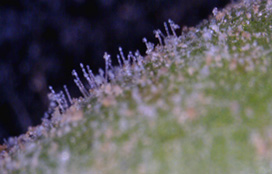
|
|
|
|

|
|||
|
|
|||
|
|
|||
Spring is a time of transition for agriculture in the desert southwest. Cool
season crop harvest is wrapping up and spring and summer crops are being planted
and grown. This is also powdery mildew season. Powdery mildew can develop on commercial
crops, such as late-season lettuce, wheat or melons, as well as landscape plants.
It is not too early to begin considering management options for powdery mildew on
melons. Some risk factors that support development of powdery mildew on melons include
a lack of rainfall, moderate temperature and relative humidity levels, dense plant
canopy, fertile soil, and succulent plant growth. The overall risk of powdery mildew
increases as more of these factors are present in a melon field. Lack of rainfall
and fertile soil are givens in our desert melon production fields. Spores of the
melon powdery mildew pathogen, Podosphaera xanthii, can germinate to initiate disease
at temperatures ranging from 72 to 88°F, and optimally at about 82°F. These moderate
temperatures as well as reduced light intensity within a dense leaf canopy and succulent
plant growth all become increasingly prevalent as the melon plantings grow rapidly
during April, May, and June. Another factor to consider when determining powdery
mildew risk is the inherent susceptibility of the melon cultivar being grown. Those
varieties known to be susceptible to powdery mildew will require implementation
of a rigorous disease management program involving applications of fungicides with
differing modes of action throughout the period of high disease risk. On the other
hand, melon varieties that have moderate to high levels of genetic resistance to
the pathogen will require less or perhaps no fungicide inputs. To achieve maximum
levels of disease control, powdery mildew fungicide application programs need to
be initiated before the visible detection of the fungus. Good levels of disease
control can also be attained by waiting to begin fungicide applications until no
later than the very first sign of disease in the field. These initial infection
sites are often on the underside of leaves, so frequent and comprehensive examination
of the melon planting is required.

To contact Mike Matheron go to: matheron@ag.arizona.edu.
|
|||
| Back | |||
|
For questions or comments on any of the topics please contact Marco Pena at the Yuma Agricultural Center.
|
|||
|
Home |
Cotton | Veggies |
Forages | Grains
| Citrus |
Crop x Crop Insects | Diseases| Weeds | Pesticides | Economics | News | Weather | Research | Photos | Contacts | General Info. Copyright © 2001 University of Arizona, College of Agriculture and Life Sciences Webmaster: Al Fournier (acis@ag.arizona.edu) |
|||
